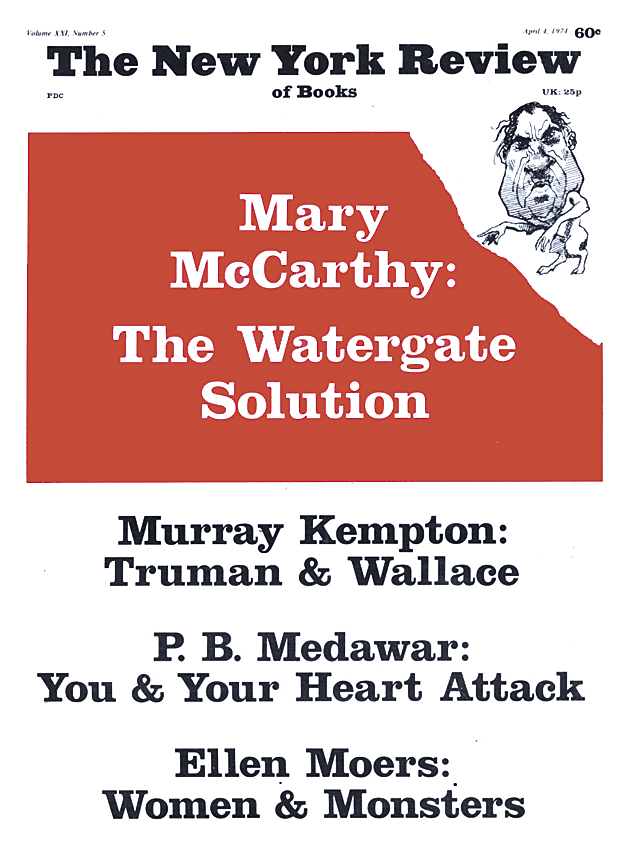In response to:
Shots of Donatello from the January 24, 1974 issue
To the Editors:
I was astonished to read John Pope-Hennessy’s vitriolic review of Donatello, Prophet of Modern Vision [NYR, January 24], since on two occasions (he only mentions one), he went out of his way to tell me how much he liked my photographs. He writes that he didn’t have the heart to say how “insensitive and meretricious” he thought they were. That was kind of him, but why did he tell me they were the best photographs of Donatello he had seen? He also claims that he was “surprised” to receive a letter afterwards from Milton Fox describing his “crazy” idea to publish the photographs in a large format, although I had made it clear that the purpose of my visit was to invite him to write the text for such a publication (which he declined because of “other commitments”). I also wonder—with amazement—what prompted him to invite me back to his office again last year when he greeted the first proofs of the book with equal enthusiasm.
Fortunately I had a companion with me who can testify to his complimentary remarks. What he didn’t like was my statement that the author, Professor Hartt, and I took issue with some of his strongly held views on Donatello. Perhaps this turned him against the photographs as well. In any case, either he is not being truthful now, or he was dishonest then; one or the other is inexcusable in a man of Sir John’s stature. When opinions are honestly sought, they should be honestly given. To do otherwise wrongs the seeker and dishonors the otherwise respected authority.
Assuming that he now means what he writes, he is correct to describe me as an “enthusiast” of Donatello’s work. But he goes on to call me an “excitable, rather self-indulgent photographer, whose concern is less with truth [sic] than with photography as the record of emotional response”! That’s more of a slur against the art of photography than a criticism of my work. It challenges the very idea of making photographic studies of sculpture as a means of discovering and recording the impact of the work. No one who respects photography as an art form would agree with him that this turns sculpture into “camera fodder.”
As for his objection to enlarged details, he might refer to Alfred Stieglitz’s explanation (as quoted in The Daybooks of Edward Weston) of why he put his “lens a foot from the sitter’s face because…when talking intimately one doesn’t stand ten feet away.” One doesn’t stand ten feet away to see the magnificent relief of the Pazzi Madonna either, and I put my lens a foot away from the sculpture to show the beauty of the exquisitely carved details. Howard Conant, in his Arts Magazine review of Donatello singled out these particular photographs for special commendation because they revealed “compelling, Arp-like sculptural forms” and were a “fascinating extension of Malraux’s ‘museum without walls’ theory of the explicatory, beyond-the-original, out of context and yet peculiarly in-context nature of photographic enlargements of works of art.” Sir John, who thinks these “smudgy plates” violate “the frontier between interpretation and misinterpretation,” seems ready to deny photographers the mission of the artist to “get deep into the very innermost nature” of things (Stieglitz).
I might add that he is mistaken about the lighting in these photographs. In an effort to reproduce an undistorted view of Donatello, most of the sculptures were photographed without any artificial lighting at all. This required exposures as long as eight minutes in some instances. Whenever lights were used, they were always placed on the side of the natural light source thereby avoiding the deceptive shadows which have marred many earlier photographs.
His remarks about color unfortunately betray ignorance of the photographic and printing processes. This is not surprising since his volumes on Italian Renaissance sculpture and the Portrait in the Renaissance do not contain a single color plate (other than a garish multi-color monstrosity on the jacket of the latter for which we cannot blame him). All color film distorts with long exposures, and the Japanese printers of this book made as many as three sets of proofs to correct this distortion. In most of the 193 color plates they did a marvelous job, eliciting high public praise from Kenneth Clark, Henry Moore, Thomas Hoving, James Johnson Sweeney and many others. Sir John preferred to dwell on those few plates which were less successful.
With his admitted lack of candor in his initial comments, his current perception of the role of photography as a non-art form and his misleading statements about lighting and color, Sir John has written an altogether dismaying review, and done a disservice to the field of art book publishing.
David Finn
New York City
This Issue
April 4, 1974


